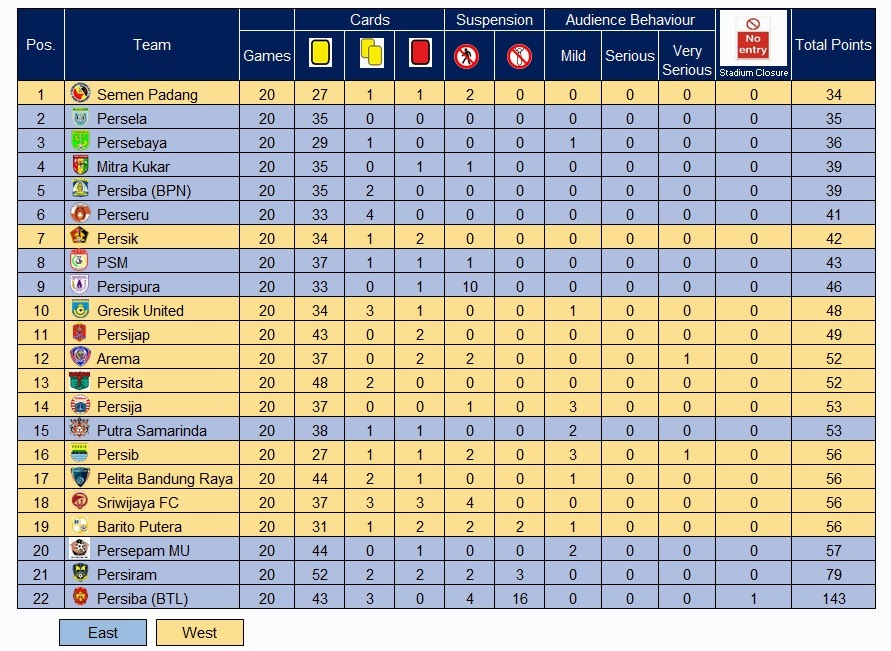 |
| source: ligaindonesia.co.id |
The qualifying round, however, has left several notes on the record book. Based on official tally, from 220 matches (110 from each West and East zones), there are 597 goals (304 West, 293 East) scored in which 7 of them were own goals (4 West, 3 East) and 76 of them were scored from the penalty’s spot (41 West, 35 East). Also, the season recorded 1,546,674 attendance (1,124,574 West, 422,100 East) with 7,030 in average.
In terms of disciplinary, the 220 matches from both Zones have produced 841 yellow cards (413 West, 428 East), and 22 red cards (15 West, 7 East). In average, there are 3.8 yellow cards per match, and 1 red card in every 10 matches.
Speaking of disciplinary, the Indonesian Football Association (PSSI) have also imposed several sanctions and fines on clubs for violations done by their players and personnel. Sanctions and fines were also given for negative behaviors caused by supporters in a match. Also, based on the regulation, when a team receives 5 or more bookings in a match, the team will be fined as well. Here’s the list of sanctions and fines imposed by the Indonesian FA’s (PSSI) Disciplinary Committee in the 2014 ISL (From February to August 2014):
 |
| Flare burning, major cause of fines source: bolaindo.com |
The sanctions and fines were imposed for several reasons, mostly unsportmanship behavior from players and flare burning and throwing of object into the pitch by supporters.
This season, the Disciplinary Committee is more active on imposing sanctions and fines. In total, they have imposed fine of IDR 2,400,000,000 on ISL clubs throughout the qualifying round of the season, and that doesn’t include fines on clubs in Divisi Utama. It is good to make the perpetrators learn some lessons and behave themselves, but that sum of money should also be used to improve the quality of referees and their linesmen. Many questionable decision made by the refs and/or the linesmen still occurred in the 2014 ISL. The point is: sanctions and fines should not be imposed on players and club’s personnel only, but also on referees and linesmen who made questionable decisions way too often. Because, it is quite obvious that some –though not always- unsportmanship behavior done by players and club personnel were caused by those unfair decisions.
 |
| Still, many questionable decisions made by ISL referees and linesmen this season source: indopos.co.id |
 |
| Total amount of fines per club click on image to enlarge |
 |
| Hinca Panjaitan, Head of Disciplinary Committee source: sundul.com |
 |
| Ferdinand Sinaga, opened a tab and made routine deposit to the Disciplinary Committee source: bola.okezone.com |
 |
| 2014 ISL Disciplinary Table click on image to enlarge |
 games of suspension (player) = as many as banned games
games of suspension (player) = as many as banned games games of suspension (club's personnel) = 5 points/banned games
games of suspension (club's personnel) = 5 points/banned games audience behaviour = determined by amount of fine
audience behaviour = determined by amount of fine- IDR 0 - 100,000,000 = mild
- IDR 100,000,000 - 200,000,000 = serious
- > IDR 200,000,000 = very serious
*when serious incidents happen which are punished by the closure of stadium
 |
| Semen Padang, most behaved team in 2014 ISL qualifying round source: fcsemenpadang.com |
 |
| Persiram, collected more bookings than any other 2014 ISL contestants source: goal.co.id |
Disciplinary Committee Release, February 12
Disciplinary Committee Release, February 19
Disciplinary Committee Release, February 27
Disciplinary Committee Release, April 21
Disciplinary Committee Release, 8 May
Disciplinary Committee Release, 12, 22, 31 May
Disciplinary Committee Release, June 12
Disciplinary Committee Release, July 10
Appeal Committee Release, July 11
Disciplinary Committee Release, August 6
Disiciplinary Committee Release, 14, 21, 26 August
Sanction for Syakir Sulaiman
Card data sourced and processed from ligaindonesia.co.id and cross-referenced with goal.com

























